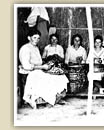
which were necessary to obtain substantial profits, as for instance was the case with grain. On the contrary,
the smaller farms took to intensive cultivation of products such as raisins and olive oil.
That is, each farmer's stremmata (1 stremma = 0.10 hectares) of vines or olive trees demanded a long period of intensive and arduous labour, but brought about
considerable profit. Thus the rural household ensured its survival with only a
small amount of land.
The area of northern and western Peloponnese yielded raisins of good quality,
which were particularly competitive in the world market. In this period,
raisins were one of the country's basic exports and constituted
a regulatory factor in the balance of foreign transactions
and the influx of exchange. The raisins of the Peloponese were in great demand
in Great Britain.
Phylloxera, a plant disease that had struck the French vines in the late
nineteenth century, enormously increased the demand for Peloponnesian raisins
as French viticulturists made up for their losses with Greek grapes.
In the 1880s and 1890s the production of raisins increased rapidly
to cover the French demand, while at the same time the price also increased. However,
from the mid-1890s onwards French production resumed its initial levels
and the demand for Greek raisins fell as rapidly as it had risen a few years earlier.
Thus, in the late 1890s and the early 1900s a crisis of overproduction of raisins
occurred, where a large part of the production remained unsold, whereas the small quantiy
absorbed by the market had a very low price.
|
